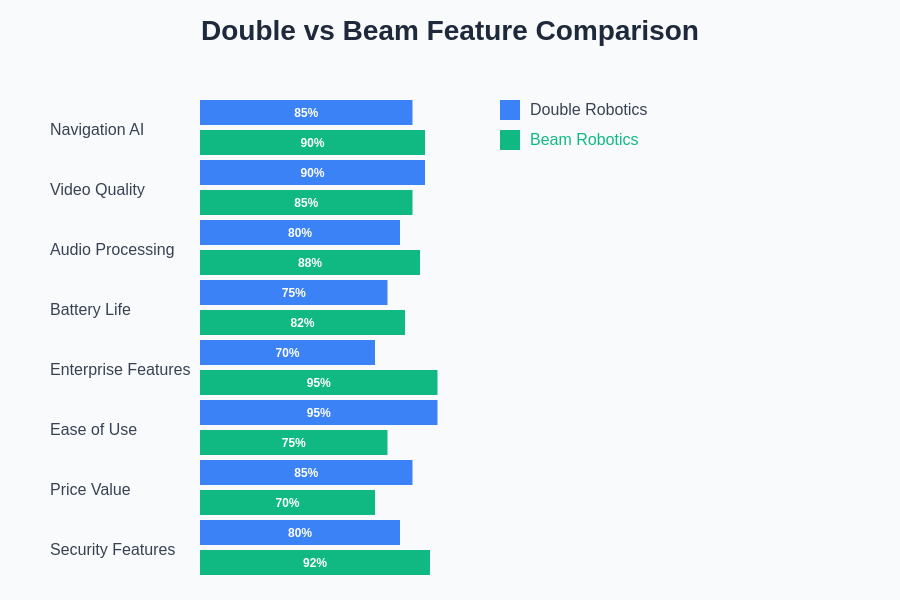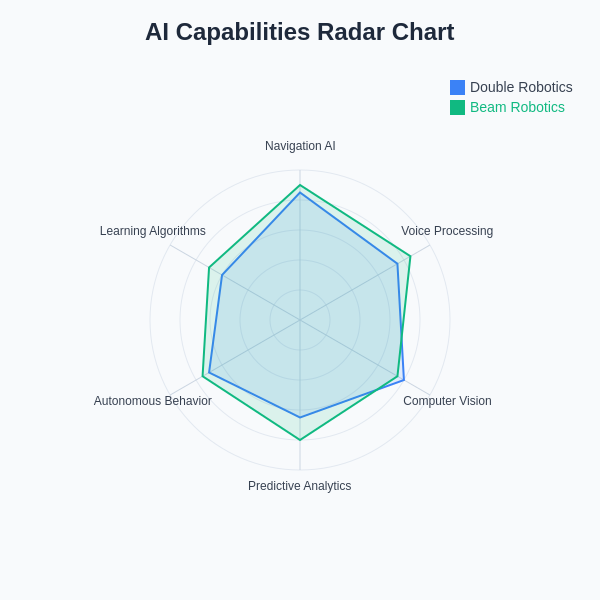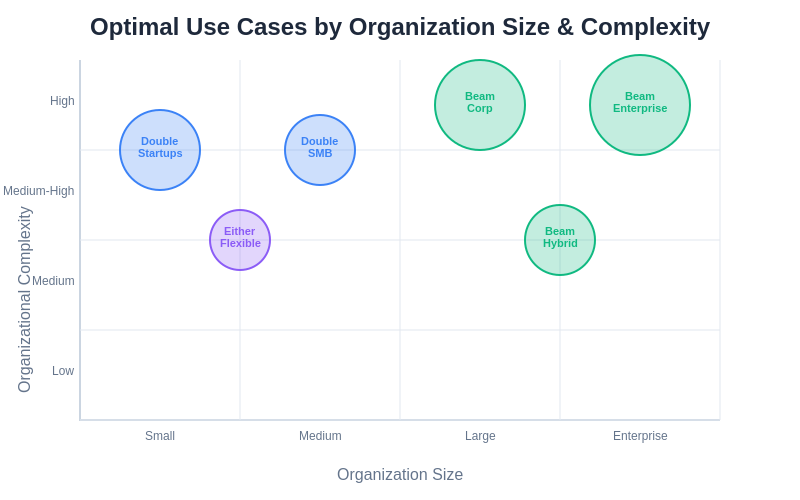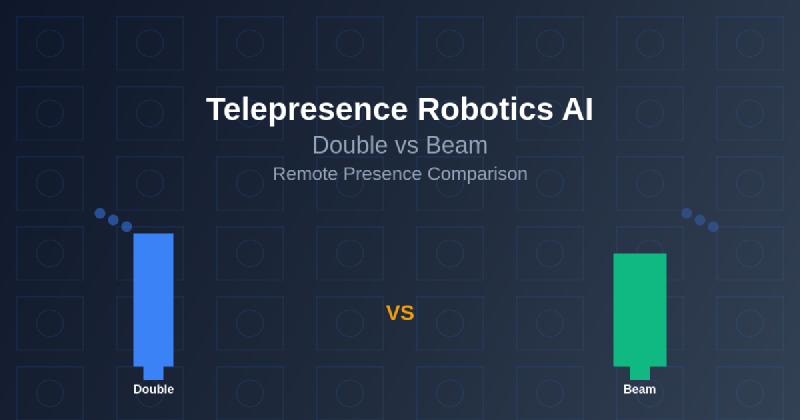The evolution of remote work and virtual collaboration has reached a pivotal moment with the emergence of sophisticated telepresence robotics systems that transcend traditional video conferencing limitations. These advanced AI-powered platforms represent a revolutionary approach to remote presence, enabling individuals to navigate physical spaces, interact with colleagues, and participate in meetings with unprecedented levels of immersion and control. Among the leading solutions in this rapidly expanding market, Double Robotics and Beam have established themselves as prominent players, each offering unique approaches to solving the complex challenges of remote physical presence through innovative technology integration and user-centric design philosophies.
Explore cutting-edge AI robotics trends to understand how telepresence technology is reshaping workplace dynamics and remote collaboration paradigms. The convergence of artificial intelligence, robotics, and communication technologies has created unprecedented opportunities for maintaining human connections across geographical boundaries while preserving the nuanced interactions that define effective teamwork and organizational culture.
Understanding Telepresence Robotics Technology
Telepresence robotics represents a sophisticated fusion of artificial intelligence, mechanical engineering, and advanced communication technologies designed to create immersive remote presence experiences that closely approximate physical attendance. These systems integrate high-definition cameras, omnidirectional microphones, spatial audio processing, intelligent navigation algorithms, and real-time video streaming capabilities to enable remote users to move freely through physical environments while maintaining natural communication with on-site personnel. The underlying technology stack encompasses computer vision for obstacle detection and navigation, machine learning algorithms for environmental mapping and route optimization, and sophisticated sensor fusion techniques that enable autonomous movement while ensuring safety and reliability in dynamic workplace environments.
The artificial intelligence components embedded within modern telepresence robots extend far beyond simple remote control functionality, incorporating advanced features such as automatic height adjustment based on interaction context, intelligent battery management systems that optimize operational duration, predictive maintenance algorithms that monitor system health and performance metrics, and adaptive communication protocols that adjust audio and video quality based on network conditions and usage patterns. These intelligent systems learn from user behavior patterns, environmental conditions, and interaction preferences to provide increasingly personalized and efficient remote presence experiences that adapt to specific organizational needs and individual user requirements.
Double Robotics: Innovation in Mobile Telepresence
Double Robotics has established itself as a pioneering force in the telepresence robotics industry through its commitment to elegant design, intuitive operation, and robust performance characteristics that address the diverse needs of modern remote work environments. The Double 3 represents the company’s flagship offering, featuring a sleek vertical design that prioritizes mobility, stability, and user-friendly operation while incorporating advanced AI-driven navigation capabilities that enable seamless movement through complex office layouts and collaborative spaces.
The Double 3’s sophisticated sensor array includes precision LIDAR mapping technology, ultrasonic proximity sensors, and advanced computer vision systems that work in concert to create detailed environmental maps and enable safe autonomous navigation through dynamic workplace environments. The robot’s AI-powered pathfinding algorithms continuously analyze environmental conditions, identify optimal routes between destinations, and adapt to changing circumstances such as moved furniture, closed doors, or crowded spaces. This intelligent navigation system reduces the cognitive load on remote users while ensuring consistent and reliable movement throughout the workspace.
Experience advanced AI capabilities with Claude to explore how machine learning enhances telepresence robotics through intelligent automation and adaptive user interfaces. The integration of sophisticated AI systems enables Double Robotics to provide increasingly autonomous operation while maintaining the human control and interaction that defines effective remote presence experiences.
Double Robotics has implemented comprehensive security protocols and enterprise-grade features that address the stringent requirements of corporate environments, including encrypted communication channels, secure user authentication systems, and administrative controls that enable IT departments to manage device deployment, monitor usage patterns, and ensure compliance with organizational security policies. The platform’s cloud-based management infrastructure provides centralized control over multiple robot deployments while offering detailed analytics and reporting capabilities that help organizations optimize their telepresence investments and measure the impact on collaboration effectiveness and employee satisfaction.
Beam Robotics: Enterprise-Focused Remote Presence
Beam Robotics approaches telepresence technology from a distinctly enterprise-oriented perspective, emphasizing robust construction, comprehensive feature sets, and seamless integration with existing corporate infrastructure and communication platforms. The Beam Smart Presence System incorporates advanced AI algorithms that enable sophisticated autonomous behaviors, including automatic docking for charging cycles, intelligent meeting room navigation, and adaptive audio processing that optimizes communication quality based on environmental acoustics and participant positioning.
The Beam platform distinguishes itself through its comprehensive ecosystem approach, providing not only the physical telepresence robots but also sophisticated software management tools, integration capabilities with popular enterprise applications, and extensive customization options that enable organizations to tailor the telepresence experience to their specific operational requirements and corporate branding guidelines. The system’s AI-powered scheduling integration automatically coordinates robot availability with calendar systems, optimizes usage patterns across multiple devices, and provides predictive insights that help organizations maximize the return on their telepresence technology investments.
Beam’s focus on enterprise deployment extends to its robust hardware architecture, which incorporates redundant communication systems, enhanced battery management technologies, and ruggedized construction designed to withstand the demands of continuous professional use in high-traffic corporate environments. The platform’s advanced AI capabilities include sophisticated noise cancellation algorithms, automatic camera positioning based on speaker detection, and intelligent bandwidth management that ensures consistent performance across varying network conditions and usage scenarios.
Comparative Analysis: Design Philosophy and User Experience
The fundamental design philosophies underlying Double and Beam telepresence systems reflect different approaches to solving the complex challenges of remote physical presence, with each platform emphasizing distinct aspects of user experience, operational efficiency, and technological integration. Double Robotics prioritizes simplicity, elegance, and intuitive operation, creating a telepresence experience that minimizes the learning curve for both remote users and on-site colleagues while maintaining sophisticated underlying technology that handles complex navigation and communication tasks transparently.
Beam Robotics adopts a more comprehensive enterprise-focused approach that emphasizes feature richness, integration capabilities, and administrative control options that appeal to IT departments and organizational decision-makers responsible for large-scale technology deployments. This philosophical difference manifests in various aspects of system design, from user interface complexity and customization options to hardware construction choices and software integration capabilities that reflect each company’s target market and use case priorities.
The user experience design choices made by each platform reflect these underlying philosophical differences, with Double emphasizing streamlined operation and minimal cognitive overhead for users, while Beam provides more extensive control options and configuration possibilities that enable organizations to optimize the telepresence experience for specific use cases and operational requirements. These design decisions impact everything from initial setup procedures and daily operation workflows to maintenance requirements and long-term scalability considerations that influence organizational adoption and user satisfaction metrics.

The comprehensive feature analysis reveals distinct strengths and positioning strategies for each telepresence platform, with Double excelling in user-friendly operation and cost-effectiveness while Beam demonstrates superior enterprise features and security capabilities. These performance differentials directly impact organizational selection criteria and deployment success metrics across diverse use case scenarios.
Technical Specifications and Performance Metrics
The technical capabilities of Double and Beam telepresence systems encompass a wide range of specifications that directly impact user experience, operational efficiency, and deployment feasibility across different organizational contexts. Double 3 incorporates a precision-engineered drive system that provides smooth, quiet operation with exceptional maneuverability in confined spaces, while its advanced sensor suite enables accurate obstacle detection and autonomous navigation through complex office environments without requiring extensive infrastructure modifications or environmental preparation.
The Double platform’s communication subsystems feature high-definition video streaming capabilities with adaptive quality adjustment, omnidirectional audio capture with advanced noise cancellation, and low-latency communication protocols that minimize delays and ensure natural conversation flow during remote interactions. The system’s AI-powered battery management extends operational duration while providing predictive charging recommendations that optimize device availability and minimize operational disruptions.
Beam’s technical specifications emphasize enterprise-grade performance and reliability, incorporating robust hardware components designed for continuous operation in demanding corporate environments. The platform’s advanced sensor array includes multiple camera systems with automatic switching capabilities, sophisticated audio processing that adapts to varying acoustic environments, and comprehensive connectivity options that ensure reliable communication across diverse network infrastructures and organizational IT environments.
Enhance your research capabilities with Perplexity to access comprehensive technical documentation and comparative analysis resources that provide detailed insights into telepresence robotics specifications and performance characteristics. The rapidly evolving nature of this technology requires continuous monitoring of emerging capabilities and feature enhancements that impact purchasing decisions and deployment strategies.
AI Integration and Intelligent Features
The artificial intelligence capabilities integrated into modern telepresence robotics systems represent a significant advancement beyond traditional remote-controlled devices, incorporating sophisticated machine learning algorithms that enhance user experience, operational efficiency, and autonomous functionality. Double Robotics has implemented advanced computer vision systems that enable real-time environmental analysis, automatic obstacle avoidance, and intelligent path planning that adapts to changing workspace conditions and user preferences over time.
The AI-driven features of Double’s platform include predictive maintenance algorithms that monitor system health and component performance, automatic height adjustment based on interaction context and user preferences, and intelligent battery management that learns from usage patterns to optimize charging cycles and operational availability. These machine learning capabilities continuously improve system performance through data analysis and pattern recognition that enables increasingly personalized and efficient remote presence experiences.
Beam’s artificial intelligence integration focuses on enterprise-oriented automation and optimization features that reduce administrative overhead while enhancing user productivity and collaboration effectiveness. The platform’s AI capabilities include automated meeting room navigation that integrates with calendar systems and facility management software, intelligent audio processing that adapts to meeting dynamics and participant positioning, and predictive analytics that provide insights into usage patterns and optimization opportunities for organizational telepresence deployments.

The artificial intelligence capabilities comparison demonstrates the sophisticated machine learning implementations across both platforms, with each system excelling in different aspects of autonomous operation and intelligent automation. These AI-driven features represent the technological foundation that enables telepresence robots to function as effective remote presence solutions rather than simple remote-controlled devices.
Deployment Considerations and Infrastructure Requirements
Successful telepresence robotics deployment requires careful consideration of infrastructure requirements, organizational workflows, and user adoption strategies that ensure maximum value realization and sustained usage across diverse organizational contexts. Double Robotics emphasizes simplified deployment procedures that minimize infrastructure modifications and IT support requirements, enabling rapid implementation with minimal organizational disruption and technical complexity.
The Double platform’s infrastructure requirements are designed to integrate seamlessly with existing corporate networks and communication systems, utilizing standard WiFi connectivity and cloud-based management services that eliminate the need for extensive on-premises server installations or complex network configuration changes. This approach reduces deployment costs and timeline while ensuring compatibility with diverse organizational IT environments and security policies.
Beam’s deployment model emphasizes comprehensive integration with enterprise systems and workflows, providing extensive customization options and administrative controls that enable IT departments to tailor the telepresence experience to specific organizational requirements and security policies. The platform’s enterprise focus includes detailed deployment planning services, comprehensive training programs, and ongoing support services that ensure successful adoption and sustained value realization across large-scale organizational implementations.
Security and Privacy Considerations
The security and privacy implications of telepresence robotics deployment represent critical considerations that influence organizational adoption decisions and operational policies governing remote presence technology usage. Both Double and Beam have implemented comprehensive security frameworks that address the unique challenges associated with mobile robotic devices that capture audio and video while navigating through sensitive corporate environments.
Double Robotics has incorporated enterprise-grade encryption for all communication channels, secure authentication protocols that prevent unauthorized access, and comprehensive privacy controls that enable organizations to manage data collection, storage, and transmission according to their specific security policies and regulatory requirements. The platform’s security architecture includes regular software updates, vulnerability monitoring, and incident response procedures that ensure continued protection against emerging threats and security challenges.
Beam’s security approach emphasizes compliance with enterprise security standards and regulatory requirements, incorporating multiple layers of protection including encrypted communication protocols, secure device management capabilities, and comprehensive audit logging that enables organizations to monitor usage patterns and ensure compliance with internal policies and external regulatory requirements. The platform’s security features include role-based access controls, geographic usage restrictions, and detailed reporting capabilities that support security monitoring and compliance verification processes.
Cost Analysis and Return on Investment
The financial considerations associated with telepresence robotics implementation encompass initial acquisition costs, ongoing operational expenses, and the quantifiable benefits that organizations realize through reduced travel expenses, improved collaboration effectiveness, and enhanced remote work capabilities. Double Robotics positions its platform as a cost-effective solution that provides significant value through simplified deployment, minimal maintenance requirements, and proven productivity benefits that justify the investment through measurable improvements in remote collaboration and employee satisfaction.
The total cost of ownership for Double’s telepresence solution includes the initial device purchase, optional service plans, and minimal ongoing operational expenses related to network connectivity and basic maintenance procedures. The platform’s design emphasizes reliability and longevity while minimizing support requirements and operational complexity that could increase long-term costs or reduce system availability and user adoption rates.
Beam’s enterprise-focused approach reflects higher initial investment requirements but provides comprehensive feature sets and support services that may offer superior value for large-scale deployments or organizations with complex integration requirements and extensive customization needs. The platform’s cost structure includes device acquisition, software licensing, deployment services, and ongoing support programs that ensure sustained value realization and continued system optimization over extended operational periods.

The optimal selection criteria for telepresence robotics platforms depend significantly on organizational size, complexity requirements, and specific use case scenarios. This strategic framework helps decision-makers identify the most suitable solution based on their unique operational context and scalability requirements, ensuring alignment between technology capabilities and organizational objectives.
Future Developments and Market Trends
The telepresence robotics industry continues to evolve rapidly through technological advancement, market expansion, and increasing organizational adoption of remote work technologies that drive demand for sophisticated physical presence solutions. Both Double and Beam are investing significantly in research and development initiatives that promise to enhance AI capabilities, improve user experiences, and expand the applications and use cases that benefit from telepresence technology integration.
Emerging trends in telepresence robotics include enhanced artificial intelligence capabilities that enable more sophisticated autonomous behaviors, improved integration with emerging communication platforms and collaboration tools, and expanding applications beyond traditional office environments into healthcare, education, and specialized industrial contexts. These developments suggest continued growth and innovation in the telepresence market as organizations seek more effective solutions for remote collaboration and physical presence challenges.
The convergence of telepresence robotics with other emerging technologies such as augmented reality, advanced AI assistants, and IoT ecosystem integration promises to create even more powerful and versatile remote presence solutions that blur the boundaries between physical and virtual collaboration. These technological developments will likely influence purchasing decisions and deployment strategies as organizations evaluate telepresence investments in the context of broader digital transformation initiatives and evolving workplace requirements.
The competitive landscape in telepresence robotics continues to expand as new entrants introduce innovative solutions and established technology companies explore opportunities to integrate telepresence capabilities into their existing product portfolios. This increased competition drives continued innovation while potentially reducing costs and expanding the range of available solutions that organizations can consider for their specific remote collaboration requirements and budget constraints.
Disclaimer
This article is for informational purposes only and does not constitute professional advice regarding telepresence robotics selection or implementation. The information presented reflects current understanding of available technologies and market conditions, which may change over time. Readers should conduct thorough research, evaluate their specific organizational requirements, and consult with qualified technology professionals before making telepresence robotics investment decisions. Performance characteristics, pricing, and feature availability may vary based on specific configurations, deployment contexts, and vendor terms and conditions.
